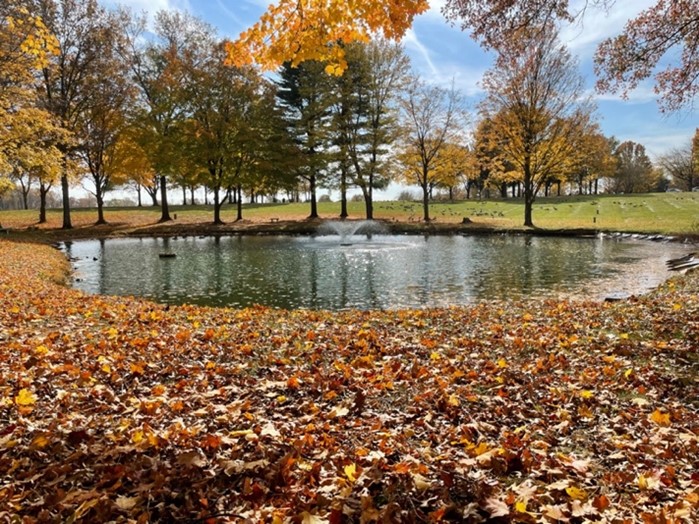If art is a way to access the past and share the beauty in it, can a cemetery be considered art? We can feel inspired and awestruck at the beauty art conveys or be shocked or angry at the message it communicates. Art can be a way of remembering something or someone, like a history book or old portrait. A cemetery holds memories and is appreciated by many as a final resting place for their loved ones.
Walking through Garrison Forest Veterans Cemetery for the first time, I was surprised how intricate these plots can be. The idea of walking around the cemetery was intriguing, especially since I had never been to one before. Walking on Veteran’s Day honored those veterans who were lost to us. I was able to remember them in a sense and respect what they did for each of us. Each one of them was appreciated and remembered here. There were rows of beautiful, marbled stones with intricately carved names and “in loving memory” on flower holders. Looking at the names sparked imagination on what each person was like and the life they lived while I followed the green grass path. After walking down the rows, there was a pond with a fountain and the water was glistening in the sunlight. The trees surrounding it were dropping leaves in incredible oranges, reds, and yellows. These colors are a great contrast to the man-made gravestones and add bright colors to bring good thoughts and memories.
Sitting down in front of a tree in a shaded area I began thinking again, a cemetery was beautiful? I thought it was wrong but then why should it be? The families, friends, and other loved ones try so hard to make the place where their fallen and loved are buried an amazing final resting place. A passage in Frederic Gros’ book, A Philosophy of Walking,stood out to me and it went along with this idea. He said “you walk as if you were letting yourself float in water, to dilute the sorrow and drown yourself in it. Let your sadness sail away in the free air; let yourself go.” The long rows of stones could leave a person in a slow trance and help them let their grief pass. They could sit and rest on a bench watching the water fall gracefully and find solace in their setting and their memories. These small additions allow people to walk and feel the sorrow of their loved one while surrounded by beauty that completes their great memories.
Julian Baggini wrote a book called The Pig That Wants to Be Eaten: 100 Experiments for the Armchair Philosopher. The idea of nature as the artist was brought up in his 37th section titled “Nature the Artist”. The trees, leaves, pond, etc. are all their own works of art brought about almost entirely by nature’s hand. You could argue that people maintain these grounds, but nature ultimately holds the paintbrush. This makes part of the cemetery grounds an artistic piece, but can the stones and statues themselves be considered a work of art?
Each stone with the veteran’s name carved in it tells a story, it shares a history. Their names share this message and brings a magnificence to their life. For example, William Beaven and his wife Margaret were just one of the many couples I saw sharing a plot together. They were born the same year and he served during the Korean war. William died in 1988 however, she lived until 2007. Both were alive during three U.S. wars: WWII, Korean, and Vietnam wars. Maybe the man that left the flowers for them was their son. Maybe they had three children, Margaret loved to bake, and William’s favorite color was lime green. What did the hardships of the war and serving do to them? Maybe their home was on the west coast and to cope with the war, they went to the park with their children every Friday. How did Margaret live after her husband passed? This basic stone shares a message with us, makes us think about their incredible or ordinary life, and it is a way of remembering the person. That is what art is supposed to do, convey a message and a feeling, and help you understand the past and feel inspired by the memory.
Each letter and number are detailed and carved in the stone to cherish and appreciate the lost one, whether they are a veteran or just an ‘everyday common individual’. Daniel Fisher, William A. Lehr, William D. Johnson, Louis Jones, these were just some of these incredible people whose history was preserved in this place. The beauty and history in this cemetery and others are comparable to the masterpieces in an art museum. They both share an aesthetic and incredible view with story after story of history entangled in their wonderous sights. A cemetery is a beautiful work of art, a historic place of art, and a nature filled piece of art.

This is a great artistic piece written by my great niece. It is absolutely beautiful and very thought provoking. ❤ I wish I had her depth of thinking. I think we can expect great things from this young lady!! I think this piece should be published.